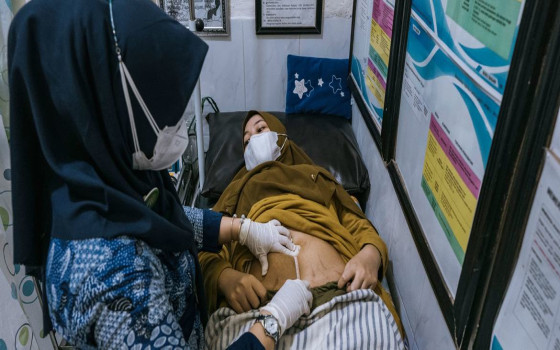
Amid geopolitical tensions, global health: A test of international cooperation on pandemics, climate, and universal health coverage

- Europe and Arabs
- Sunday , 18 May 2025 6:50 AM GMT
New York: Europe and the Arabs
Can the world be better prepared for the next pandemic? This question is at the heart of an international agreement to be negotiated in Geneva next week during the World Health Assembly meeting of the World Health Organization.
As countries continue to grapple with the impact of the COVID-19 pandemic, health leaders hope the new agreement will ensure swift action to protect lives and livelihoods when a new outbreak, or another pandemic, occurs. According to the UN Daily News,
The World Health Assembly is the highest decision-making body of the World Health Organization. It meets once a year and is attended by delegations from all member states. Its primary function is to determine the organization's policies. It also appoints the Director-General and oversees the organization's financial policies.
The agenda for the 78th Assembly is packed with topics for discussion, including pandemic preparedness, climate-related health risks, mental health, maternal care, and environmental justice. But with geopolitical tensions rising, international cooperation on these and other vital issues will be tested.
Here are some of the key areas expected to dominate the discussion.
1- Adoption of a draft agreement on pandemics and “cautious optimism”
The COVID-19 pandemic has exposed stark inequalities in access to diagnostics, treatments, and vaccines, both within and between countries. Healthcare services have been overwhelmed, economies have been severely disrupted, and nearly seven million lives have been lost.
This has been the impetus behind countries’ concerted efforts to work on an agreement that will ensure the world deals with the next pandemic more fairly and efficiently. When delegates arrive in Geneva on Monday, May 19 – the day the Assembly begins – they will discuss the text of the agreement, which WHO Director-General Tedros Adhanom Ghebreyesus described as “vital for future generations.”
If adopted, the agreement would mark a major breakthrough in the way the world deals with pandemics and health crises.
However, the negotiations remain politically sensitive. Several countries, including the United States, have expressed concerns about national sovereignty and intellectual property rights.
However, the WHO Director-General has expressed “cautious optimism” in recent weeks that a consensus can be reached. 2- Climate Change: An Existential Threat
The climate crisis is not just about rising temperatures; it also puts lives at risk, with increasing extreme weather events and disease outbreaks, threatening the health of millions.
A WHO action plan calls for concerted climate and health policies, strengthening resilience, and ensuring the necessary financing to protect vulnerable communities.
The draft plan was released following a resolution adopted at the 2024 meeting. Delegates are expected to finalize the draft this year, which includes strategies for adapting to and mitigating climate-related health risks.
3- Health for All: Putting Universal Health Care Back on Track
Ensuring that all people have access to a full range of quality, affordable health services is one of the Sustainable Development Goals.
However, the health goal is far off track, with improvements in health services stagnating over the past ten years.
Universal health care will nevertheless be a top priority for the Assembly, as delegates will discuss strategies to strengthen primary health care systems, secure sustainable financing, and provide care for vulnerable groups. 4- A Healthy Start for a Promising Future for Mothers and Newborns
Nearly 300,000 women lose their lives due to pregnancy or childbirth each year, while more than two million babies die in the first month of life.
In April, the World Health Organization launched a year-long campaign to end preventable maternal and newborn deaths.
Themed "A Healthy Start for a Promising Future," the campaign urges governments and the health sector to intensify efforts to end preventable maternal and newborn deaths and prioritize women's long-term health and well-being.
New targets and renewed commitments to ending preventable deaths are expected to be announced at the Assembly.
Finances
This year has been described as one of the most challenging ever for the United Nations, which is facing severe financial pressures. The United States, a major donor, announced its withdrawal from the WHO in January, and other countries have also cut development and aid funding. This year's World Health Assembly will see Member States negotiate a 50 percent increase in the core budget, something that has been in the works since the 2022 meeting.
If approved, the funding increase would provide a vital boost during this challenging time. WHO is also seeking additional voluntary contributions. Additional pledges from Member States and philanthropic organizations are expected.
5. Bridging the Gaps: Non-communicable Diseases
Non-communicable diseases (NCDs), such as heart disease, cancer, and diabetes, kill tens of millions of people each year. About three-quarters of these deaths occur in low- and middle-income countries.
Many lives could be saved if more countries adopted effective national responses, including detection, screening, and treatment, as well as palliative care.
In preparation for the WHO meeting on NCDs and mental health in September, delegates will review how the Organization collaborates with governments, civil society, and the private sector to prevent and control these diseases, and discuss ways to improve access to essential medicines and health technologies.












No Comments Found